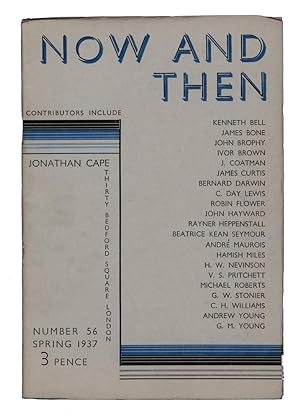
This was a literary magazine published sporadically by Jonathan Cape to promote their own new books.
The idea of such a magazine is unusual, to say the least. Your Jotter is not familiar with any other periodical of this type ( though doubtless there must be one or two) , and it is certainly sneaky to design a magazine to look almost exactly like an independent literary review, rather than a book promotion. The name of the publisher does appear on the cover of the Winter 1936 issue, which we found in our archive at Jot HQ, and in the case of The Book of Margery Kempe, the name ‘ Jonathan Cape’ appears under the blurb in an advertising panel in this issue , but in every other advert in the magazine the publisher’s name is absent, as indeed it is in every review of the books. This is surely misleading to everyone reading the magazine except those who were familiar with it and its aims. A casual reader picking up a copy of Now and Then from a bookstall back in 1936 would conclude that here was yet another literary review and only on close inspection would he or she perhaps be suspicious of its independence. The inclusion of the words ‘Jonathan Cape’ on every advert and in every review would have immediately given the game away. However, any reader sufficiently impressed by a review to seek out the books in a store might easily be offended at being taken in by a blatant piece of puffery. I wonder if Jonathan Cape lost any customers this way. Few would have expected a reputable and long established publisher, such as John Murray, to indulge in such chicanery. But the comparatively recently founded Jonathan Cape, which had begun in 1921, was evidently keen to boost its sales.
The trick, which probably began in the company’s marketing department, originated with the first issue of Now and Then in the 1920s, but was further enhanced in the ‘thirties when it adopted the art deco cover style of Geoffrey Grigson’s New Verse, with its trendy sans serif font. Up to this point Now and Then had used the conventional roman font for its cover. However, the main text and back cover remained resolutely Roman throughout its existence.
To their credit, the people at Jonathan Cape did not choose many of their own authors as reviewers. In this Winter 1936 issue, only Muriel Stuart could be classed as such. Most of the others were under fifty, although there were few older , well-known authors , such as Winston Churchill, William Beach Thomas and Grant Richards. Most were well known literary figures , although one or two, such as short story writer and novelist L. A. Pavey, James Curtis, a screenwriter and novelist, best known for ‘They Drive by Night’, and Muriel Stuart, a poet and writer on gardening, were less eminent.
However, perhaps the most popular ( in terms of sale at least) Cape writer of the decade was Beverley Nicholas ( 1898 – 83), the journalist, playwright, thriller writer and memoirist. In his mid thirties he had scored a tremendous success with the three books, Down the Garden Path, A Thatched Roof and A Village in a Valley, that recounted his life in the village of Glatton, Huntindgonshire, which he renamed ‘ Allways’. Some idea of his reputation at the time may be gained from the back cover of Now and Then in which the first cheap edition of the three titles was advertised in large type.
Here admirers of Nichols are informed that not only will this new edition contain all the original illustrations, but will have two alternative bindings: ‘ one of twin-colour line with coloured lettering and design ‘ the other with ‘ a specially devised flexible binding of fine fadeless cloth, lettered with gold ‘. Sumptuous indeed. Throughout a prolific writing life in which his sixty books ranged in subject matter from the homes and gardens stuff , through crime fiction, travel, biography and even parapsychology, Nichols, who also wrote for Women’s Own and was a broadcaster, is still best known for these three books and others in the same vein. Your Jotter used to mix him up with Godfrey Winn (1906 – 71), who was also a frequent broadcaster and contributor to women’s magazines.
Today, Nichols is a largely forgotten figure, and in some circles is despised for writing approvingly in the thirties of the Fascist leader Sir Oswald Mosley, who he knew personally.
R. M. Healey
